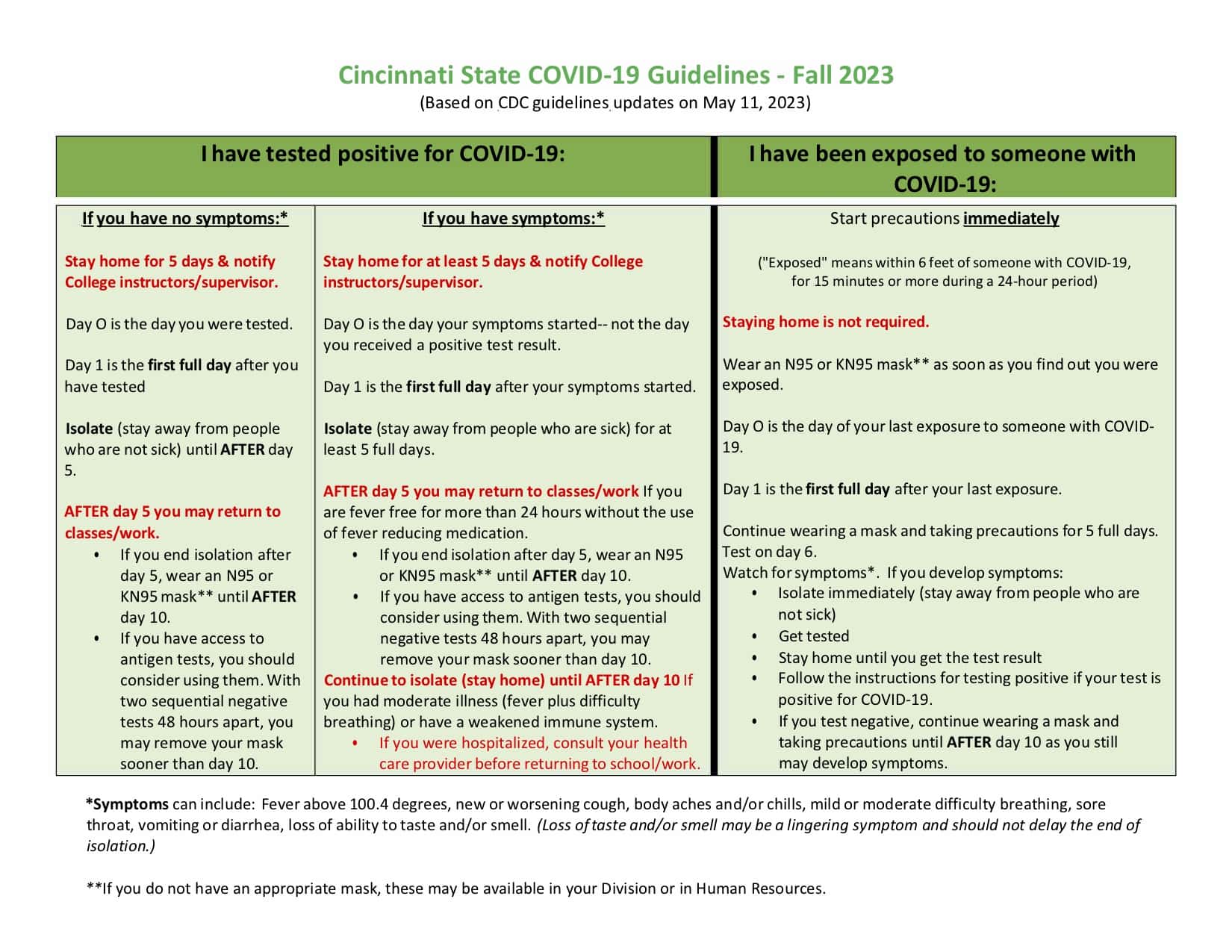Safely Staying On Track at Cincinnati State
Updated November 2023
The health and safety of the Cincinnati State community is a top priority.
On our campuses and throughout Cincinnati, medical experts and health and wellness professionals work collaboratively to help ensure a healthy environment where students, faculty, and staff members can teach, learn, work, and flourish.
During the COVID-19 pandemic, we learned we can work together to keep each other safe and reduce the spread of communicable diseases.
Respiratory viruses, including COVID, currently are active in our community.
Please review the information on this page to keep yourself and others in the Cincinnati State community safe and healthy.
COVID did not go away when it was announced the pandemic had ended. The COVID virus is still spreading.
- If you have tested positive for COVID or been exposed to COVID, please follow the steps on the flowchart below.
- If you have tested positive, please let your instructor know (if you’re a student) or let your manager/supervisor know (if you’re a College employee).
- If you have tested positive and wish to inform others with whom you were in close contact (within 6 feet for 15 minutes or more during a 24-hour period), you may. The College does not track or report COVID cases.

Please download this flowchart for guidance if:
- you test positive for COVID
- you were in close contact with someone who is positive for COVID (within 6 feet for 15 minutes or more during a 24-hour period)
More COVID Resources
Click the links below for information from the Centers for Disease Control.
- If you were exposed to COVID: https://www.cdc.gov/coronavirus/2019-ncov/your-health/if-you-were-exposed.html
- If you test positive for COVID: https://www.cdc.gov/coronavirus/2019-ncov/your-health/isolation.html
The COVID vaccine continues to be recommended to prevent the spread of COVID, or decrease the severity of the symptoms if you develop the virus.
- Information on COVID vaccines: https://www.cdc.gov/coronavirus/2019-ncov/vaccines/stay-up-to-date.html
- COVID Vaccine Locator: https://www.vaccines.gov
Seasonal influenza, usually referred to as the flu, is on the rise in our community. Like COVID, the flu can make some individuals very ill, while others have mild symptoms.
- People infected by the virus that causes the flu may be contagious about one day before they have symptoms.
- Most people with flu will be contagious for 3-4 days.
- Usually by the time flu symptoms resolve, the person is no longer contagious. COVID spreads much more easily than the flu, so it’s more contagious.
Symptoms of the flu are very similar to the symptoms of COVID. They include:
- Fever/chills
- Cough
- Shortness of breath/difficulty breathing
- Feeling tired
- Sore throat
- Runny nose or congestion
- Muscle pain/ body aches
- Headache
- Vomiting
If you believe you have the flu, you should stay home for 4 to 5 days, or until symptoms resolve, so you do not expose others to this illness.
- If you have a fever (not everyone does), you should stay home for at least 24 hours after the fever is gone without using medication such as Tylenol (acetaminophen) or Motrin (ibuprofen)
Being vaccinated is one way to prevent serious illness from the flu. The CDC recommends flu vaccinations for all.
Flu Vaccine Locator: https://www.vaccines.gov/find-vaccines
RSV, or Respiratory Syncytial Virus, is another respiratory virus currently in the news.
For most people, RSV causes mild cold-like symptoms, but it can be very dangerous for the very young (infants under 6 months), the old (adults over age 65), children and adults who are immuno-compromised, and adults with congestive heart failure (CHF), chronic obstructive pulmonary disease (COPD) and asthma.
Although most of us are safe, preventing spread of this very contagious illness can help keep safe those who are at risk for more serious illness.
Learn more about preventing the spread of RSV: https://www.cdc.gov/rsv/about/prevention.html
